


Pre-WW2 Leather Jacket Back Patch 27th Pursuit Aero Squadron AAC 1930s 15
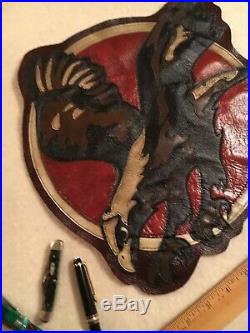
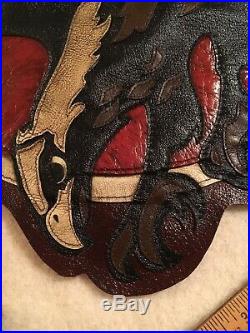
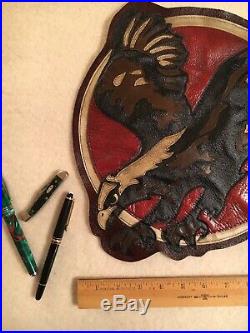
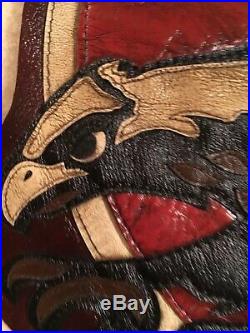
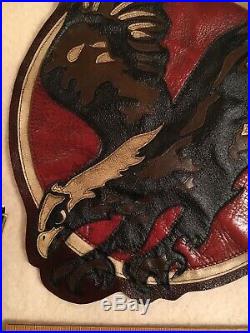
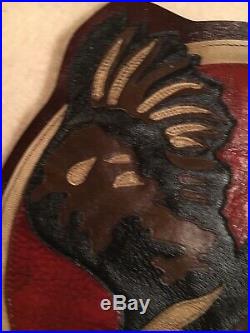
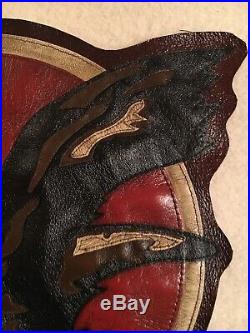
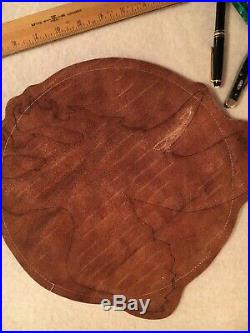
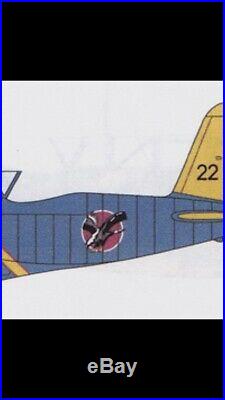
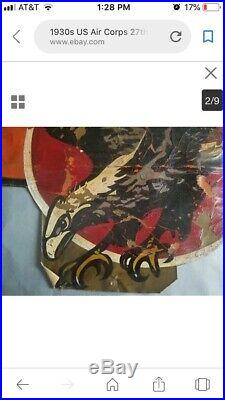
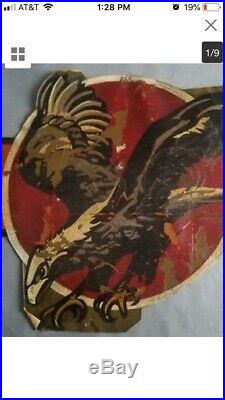
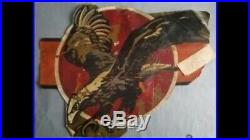

Pre-WW2 Leather Jacket Back Patch 27th Aero Pursuit Squadron AAC 1930s 15 in diameter at the widest. This a killer-looking NEWLY-made patch! Heres an exquisite, one-of-kind multi-layered-leather patch for an A2 Flight Jacket (or an earlier Army Air Corps leather jacket). I had this made for me based upon an actual hand-painted image on a canvas fuselage section removed from a 27th Aero Squadrons aircraft (depicted in pictures 10, 11, and 12). Still active as the 27th Fighter Squadron, this unit is the oldest active fighter squadron in the United States Air Force, with over 95 years of service to the nation! The 27th Fighter Squadron was organized as the 21st (later 27th) Aero Squadron on 15 June 1917 at Kelly Field, Texas. The squadron deployed to France and fought on the Western Front during World War I as a pursuit squadron. It took part in the Champagne-Marne defensive; Aisne-Marne offensive; St. Mihiel offensive, and Meuse-Argonne offensive. Lieutenant Frank Luke, Jr. Known as the “Arizona Balloon Buster, ” for his daring feats against the HEAVILY defended German observation balloons, was the squadron’s most colorful ace. His 18 victories cost him his life, and he was awarded the Medal of Honor. Aircraft flown by the 27th during World War I include the Nieuport 28, Spad XIII and Sopwith F-1 Camel. In the period between the world wars, the 27th Pursuit Squadron, re-designated 25 January 1923, was stationed primarily at Selfridge Field, Michigan, with the 1st Fighter Group. 27th Pursuit Squadron pilots participated in air races. Donald Stace of the 27th AS won the first Mitchell Trophy Race. Under extreme and austere conditions in the 1920s they tested the effects of cold weather on their aircraft. At times it was so cold, the engines of their P-1 Hawk aircraft would not start until steam was forced into the engines to thaw them. While they were stationed at Selfridge Field, Mich. Pilots from the 27th AS put on aerial demonstrations all over the country throughout the 1920s. One of those was at Langley Field in March, 1925. A large silhouette of a battleship on the grass landing strip served as a target, which was successfully strafed and bombed for several duly impressed congressmen. During World War II the unit served in the Mediterranean Theater of Operations (MTO) as part of Twelfth Air Force as a P-38 Lightning fighter squadron, participating in the North African and Italian campaigns. During the Cold War it was both an Air Defense Command fighter-interceptor squadron as later as part of Tactical Air Command. It was the first USAF operational squadron equipped with the F-15A Eagle in January 1976. The item “Pre-WW2 Leather Jacket Back Patch 27th Pursuit Aero Squadron AAC 1930s 15″ is in sale since Saturday, July 27, 2019. This item is in the category “Collectibles\Militaria\1919-38\Original Period Items”. The seller is “bataan12213″ and is located in Little Rock, Arkansas. This item can be shipped to United States.
- Brand: Aero
- Material: Leather

Rare Original 27th Inf Regt. Hawaiian Made Wolfhounds Sleeve Patch-wool-felt
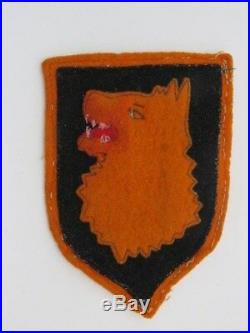
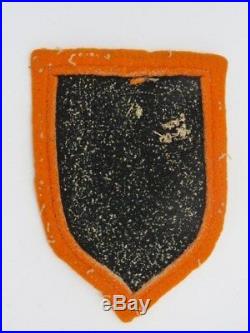

This simple but well made patch is constructed using three pieces of wool felt with the addition of a red tongue and select hand embroidery. 3 7/8 x 2 3/4 inch example is in EXCELLENT used condition! Does not fluoresce when exposed to black light. The item “RARE ORIGINAL 27TH INF REGT. HAWAIIAN MADE WOLFHOUNDS SLEEVE PATCH-WOOL-FELT” is in sale since Wednesday, January 16, 2019. This item is in the category “Collectibles\Militaria\1919-38\Original Period Items”. The seller is “dducksdaughter” and is located in Binghamton, New York. This item can be shipped to United States.

Rare Original 27th Inf Regt. Hawaiian Made Wolfhounds Jacket Patch-wool-felt
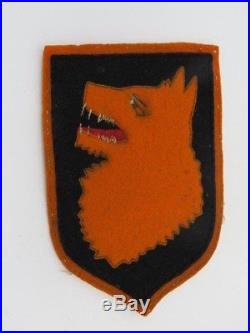
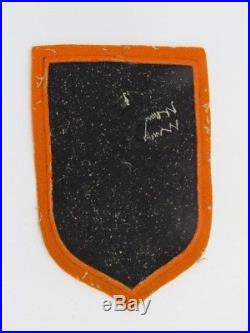

This simple but well made patch is constructed using three pieces of wool felt with the addition of a red tongue and select hand embroidery. 6 x 4 inch example is in EXCELLENT used condition! Does not fluoresce when exposed to black light. The item “RARE ORIGINAL 27TH INF REGT. HAWAIIAN MADE WOLFHOUNDS JACKET PATCH-WOOL-FELT” is in sale since Wednesday, January 16, 2019. This item is in the category “Collectibles\Militaria\1919-38\Original Period Items”. The seller is “dducksdaughter” and is located in Binghamton, New York. This item can be shipped to United States.

1930s US Air Corps 27th Pursuit Aero Squadron Aircraft Fabric Cut Canvas P-12


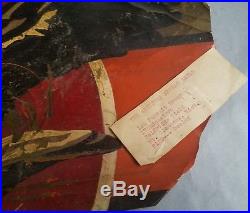



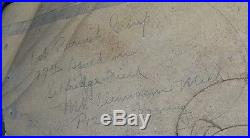
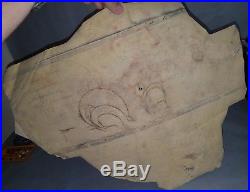
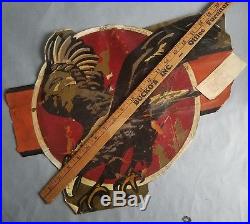

The writing states that it is from the 17th, but I believe it to be from the 27th. There is a photo of a P-12 from the 27th on Wiki that shows this insignia in use. Check out my other items! What you see in the pictures is what you get unless otherwise stated. All items are “As Is”, and if you have any questions feel free to contact me. If you have any issues at all send me a message before opening a case! The item “1930s US Air Corps 27th Pursuit Aero Squadron Aircraft Fabric Cut Canvas P-12″ is in sale since Thursday, November 8, 2018. This item is in the category “Collectibles\Militaria\WW II (1939-45)\Original Period Items\United States\Patches”. The seller is “codys_collections” and is located in Sarasota, Florida. This item can be shipped to United States.
- Country/Region of Manufacture: United States

1930s US Air Corps 27th Pursuit Aero Squadron Aircraft Fabric Cut Canvas P-12


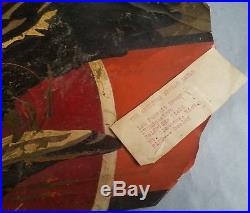



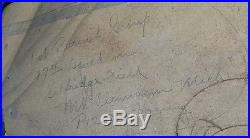
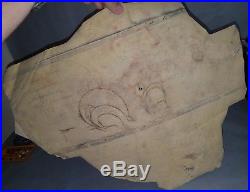
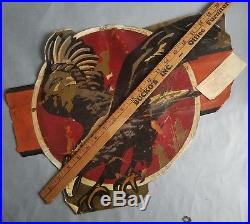

The writing states that it is from the 17th, but I believe it to be from the 27th. There is a photo of a P-12 from the 27th on Wiki that shows this insignia in use. Check out my other items! What you see in the pictures is what you get unless otherwise stated. All items are “As Is”, and if you have any questions feel free to contact me. If you have any issues at all send me a message before opening a case! The item “1930s US Air Corps 27th Pursuit Aero Squadron Aircraft Fabric Cut Canvas P-12″ is in sale since Tuesday, October 9, 2018. This item is in the category “Collectibles\Militaria\WW II (1939-45)\Original Period Items\United States\Patches”. The seller is “codys_collections” and is located in Sarasota, Florida. This item can be shipped to United States.
- Country/Region of Manufacture: United States

#411 POLAND POLISH 27th KING BATORY LANCERS REGIMENT TYPE II BADGE 1920s
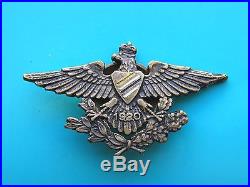
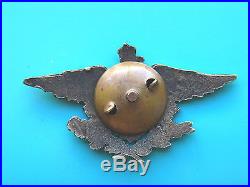

#411 27th KING STEFAN BATORY LANCERS REGIMENT BADGE, 1920, Silver gilt worn to bronze. Good enamels, made by Reising, very rare. The free listing tool. The item “#411 POLAND POLISH 27th KING BATORY LANCERS REGIMENT TYPE II BADGE 1920s” is in sale since Sunday, August 10, 2014. This item is in the category “Collectibles\Militaria\1919-38\Original Period Items”. The seller is “polishmilitaria” and is located in Ft Lauderdale. This item can be shipped worldwide.

WW1 US Army 27th Div Btry D 106 Field Artillery NY National Guard Roll of Honor
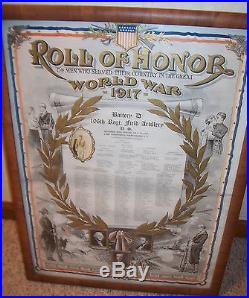
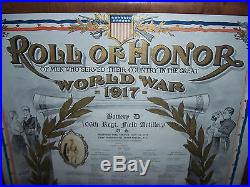
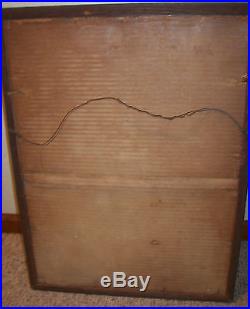
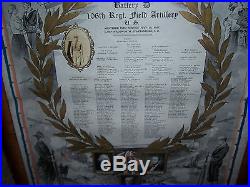


TRIBUTE TO THOSE THAT SERVED AND DIED. NEW YORK NATIONAL GUARD. What is a “ROLL OF HONOR “? It is a list of those who have died in war for their country, especially those from a particular locality or organization. On July 6, 1917, the city of Spartanburg, S. Government nearly 2,000 acres of land west of the city for an Army training camp. After a rapid construction project, the first troops arrived at Camp Wadsworth that fall. From 1917 to 1919, Camp Wadsworth served as one of America’s premier army mobilization centers. Men from all over the country New York National Guardsmen, Wisconsin recruits, the Slavic Legion of Eastern European immigrants all came to call Spartanburg home temporarily. The camp was to have a capacity of about 56,000 officers and enlisted men that would become the 27th U. By the time Wadsworth was closed on March 25, 1919, an estimated 105,000 soldiers had trained for World War I service there. 27TH DIVISION: The New York State National Guard Division was officially designated the 27th Infantry Division on July 20th, 1917. The division, which initially had nine infantry regiments grouped into three brigades was squared or reorganized into a more simplified four-regiment structure within two brigades. Some regiments were dropped from the unit, while others were renamed and enlarged. The 27th Division was eventually made up of the 53rd Infantry Brigade, consisting of the 105th and 106th Infantry Regiments, and the 54th Infantry Brigade, consisting of the 107th and 108th Infantry Regiments. The 52nd Field Artillery Brigade, which was made up of the 104th, 105th, and 106th Field Artillery Regiments and the 102nd Trench Mortar Battery was assigned as the divisional artillery, though once in Europe it never served with the 27th Division. The initial effective strength of the 27th Division was 991 officers and 27,114 enlisted men. After training at Camp Wadsworth, Spartanburg, S. The 27th was initially stationed in the East Poperinghe Line, and participated in actions at Dickebusch Lake and Vierstratt Ridge during the late summer of 1918, and then in September the struggle to break the formidable German defenses of the Hindenburg Line. On September 25th, the division participated in the Somme Offensive and provided a break through of the Hindenburg Line itself forcing the Germans into general retreat. After a final confrontation with the retreating Germans at the Le Selle River the Armistice ended the fighting and the division was sent home in February of 1919, to be mustered out several months later. In the early actions the 27th Division sustained 185 killed 1,086 wounded, and 65 who later died of their wounds. During the Somme offensive and subsequent operations the 27th lost an additional 1,237 killed, 5,328 wounded, and 308 who later died of their wounds for a total of 8,209 assorted casualties throughout the course of the war. 52nd Field Artillery Brigade 106th Field Artillery Regiment: formerly 3rd Regiment, Field Artillery, and detachments from the 1st, 71st, and 74th Regiments, Infantry, New York National Guard. NOTE PICTURE EMBEDDED, POSSIBLY ONE NAMED IN THE ROLL. It comes complete, mounted in a glass covered wood frame. Condition: For nearly 100 years old, very good. The colors are still vibrant, print and art is clear. I see no apparent blemishes. If YOU have any other information or data on this piece and would like to share it, I’d be more than willing to pass it on to any possible NEW OWNER. Please feel free to contact me. That’s about all I can tell you about this UNIQUE WORLD WAR I collectible. If you collect MILITARY HISTORY, NEW YORK NATIONAL GUARD. Or just want a good HISTORICAL POSTER for YOURSELF.. You could add this unique piece to your collection. READ the description/policies, STUDY the pictures, ASK questions! SO, BEAT HIM TO IT AND IT’S YOURS!! All you have to do is… I TRY MY VERY BEST TO PACK YOUR ITEM FOR A SAFE TRANSPORT. THANK YOU FOR YOUR UNDERSTANDING. THEREFORE, FOR THIS ITEM.. ANY CLAIM FOR DAMAGE WILL REQUIRE PICTURE PROOF OF LOSS. FEEDBACK POLICY WE ARE STRIVING FOR 5’S!! We are committed to providing you a 5-star experience when you deal with us. If we miss the mark, please let us know before you leave any feedback. I will promptly submit my feedback as soon as yours has been posted. Would you like to see more like this? Looking for former members 3rd Force Recon Co. USMC 1965 – 1970. If you were a member, or know of someone who was, please contact me. This doesn’t include change of mind! The day it leaves the factory, it becomes one day closer to it’s end date. When I find these devices, I plug them in, wind them up or put in a battery. At that point in time, I have NO IDEA of how old or how much use they have incurred. They may last a lifetime, or fail the next time they are turned on. Therefore, I sell these as “Decorative or Ornamental purposes” only, not functional. Which may be referred to as “AS IS”. Note: On some items, UPC symbols may have been removed for rebate purposes. I try to be as accurate and complete as I can in my item descriptions. I value my feedback record as much as YOU do. International Buyers Please Note. We do not mark merchandise values below value or mark items as “gifts” – US and International government regulations prohibit such behavior. XX, 11PM EASTERN, 10PM CENTRAL, 9PM MOUNTAIN 8PM PACIFIC. The item “WW1 US Army 27th Div Btry D 106 Field Artillery NY National Guard Roll of Honor” is in sale since Thursday, December 01, 2016. This item is in the category “Collectibles\Militaria\1919-38\Original Period Items”. The seller is “tradsell” and is located in Lancaster, New York. This item can be shipped worldwide.
- Country/Region of Manufacture: United States

Amazing Vintage Real Photograph Us Army 27th Infantry At Siberia Wwi 1918 1919
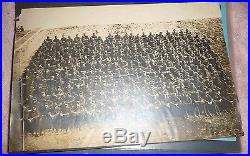
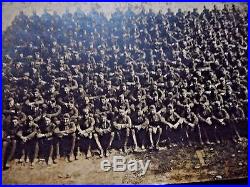
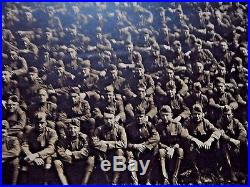
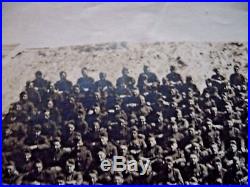
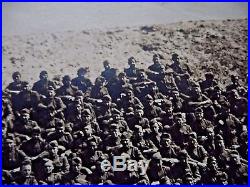
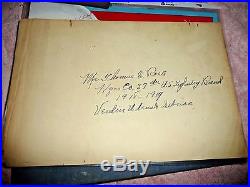
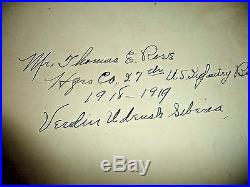

APPROXIMATELY 11 INCHES TO 7. 5 INCHES IN SIZE. Upper left corner tip chipped , otherwise a clean item. SORRY FOR THE FLASH LIGHT REFLECTIONS and sorry for our poor camera. The photo is very sharp and clear. Please do see the pics for the text on the reverse side. The Story of the American Expeditionary Forces. Doughboys Marching Through Siberia. It was a war few Americans knew about then or now. Orchestrated behind closed doors, inspired by panic, and plagued by futility, America’s military intervention in Siberia during the First World War continued long after the Armistice sent the doughboys in France home. President Woodrow Wilson considered the order to send American troops to Siberia, a region besieged by civil war, lawlessness, and murder, one of the most difficult decisions of his presidency. Despite Russia’s separate peace treaty with Germany ending the war on the Eastern Front early in 1918, Wilson hesitated to get involved in Russia’s civil war even at the Allies insistence. By Summer 1918 things changed. The mounting Japanese occupation of Siberia threatened American business interests in the East. Piles of Allied military goods amassing to over 600,000 tons of war materials laid vulnerable around the crowded city. [1] The plight of the stranded Czech Legion vulnerable to the merciless Red Army gave Wilson a much needed moral foundation for intervention. Intervention, Wilson realized, could be used later to pressure the Allies into adopting his ideas for a League of Nations. Alone at his typewriter, Wilson outlined America’s intentions in sending troops to Siberia in a seven-page document titled, Aide Memoire. It was distributed to the Allies July 17, 1918. [2] Based on complete neutrality in Russian politics and territorial integrity, it contained more diplomatic hypotheses than decisive military strategies. It was the only directive given to the commander of America’s military in Siberia. Forces in Siberia, the War Department turned to Major General William S. Graves, an intelligent and experienced officer training Eighth Division recruits at Camp Fremont, California for duty in France. On August 2, 1918, Graves received a mysterious message from the War Department ordering him to take the first train directly to Kansas City. [3] At the train station, Secretary of State, Newton D. Baker handed Graves an unsigned copy of the Aide Memoire: This is the policy of the United States in Russia which you are to follow. Watch your step; you will be walking on eggs loaded with dynamite. [4] Graves was now Commander of the AEF, Siberia. The first American troops, 1,590 from the Twenty-Seventh Infantry Regiment, arrived in Vladivostok to a cheering crowd of White Russians on August 16, 1918 followed by 1,421 troops from the Thirty-First Infantry Regiment on August 21. [5] Under the temporary command of Colonel Henry D. Styer, they disembarked into a city buried in the depths of anarchy, collapse, and ruin. Streets were littered with debris. A rancid stench filled the air. Local leaders battled for control. Without orders, Styer and his men waited for Graves to arrive and wondered why they were in this godforsaken place. In the meantime, Colonel Styer agreed to send a regiment from the 27th Infantry to accompany a Japanese division on a reconnaissance operation along the Trans-Siberian Railway. The Japanese told Styer that 15,000 German and Austrian prisoners of war and Bolsheviks headquartered in the Ussuri Valley threatened Vladivostok. [6] Despite the frigid temperatures and difficult ground, the regiment marched over 1,000 miles in pursuit of the retreating Bolsheviks resulting in the capture of Blagoveschensk. [7] The Russians, impressed with American drive, nicknamed the 27th Infantry, the “Wolfhounds”. Major General Graves arrived at Vladivostok on September 1, 1918 with 5,000 Eighth Division troops. Finding no threat to the city, he ordered the troops back to their garrison. Graves had hoped to avoid situations like the Ussuri Campaign, and interpreted from the Aide Memoire that U. Troops were not here to fight Russia or any group or faction in Russia. [8] A strict policy of neutrality was immediately announced to the troops. Bolsheviks and White Russians would be treated equally. By the time Graves arrived in Siberia, circumstances had changed. The Czech Legion no longer needed rescuing. The Japanese had 72,000 troops spread all over the region. [9] The search for German and Austria-Hungarian prisoners of war was unnecessary as they willingly turned themselves in preferring American rations and humane treatment to freedom. With little else do to, American troops patrolled and guarded the city. The Armistice in November 1918 ending the conflict in Europe gave Graves and most American soldiers in Siberia hopes of returning home. Instead, four American companies settled with the first snows of winter 300 miles south in Spasskoe. [10] While Congress questioned the intervention, Wilson found new excuses for the troops to stay. In Formation in the Snow. American troops survived a dismal winter. Temperatures frequently dropped to below sixty degrees. Frostbite was common and in some cases led to amputation. The Chief Surgeon noted that “practically” no sanitary conditions existed. [11] Drinking at the popular vodka houses and engaging prostitutes became the most popular pastimes for many bored and lonely doughboys needing an escape from the harsh conditions. By Spring 1919, the 27th Infantry found themselves divided between the Trans-Baikal region and Habarovsk on the Amur River; while detachments of the 31st Infantry were distributed along the railroad from Vladivostok to the Suchan Valley. [12] In March, the need to transport military supplies and maintain communications for the White Russians produced the Inter-Allied Railway Agreement which divided the 6,000 mile-long Trans-Siberian Railway into sectors. [13] Allied military detachments would protect their sectors from guerilla attacks and keep the railway and lines of communication open. Graves immediately issued orders to his troops: Our aim is to be of real assistance to all Russians in protecting necessary traffic movements within the sectors on the railroad assigned to us… All will be equally benefited, and all will be treated alike by our forces… [14] However, the railway was the main artery of White Russian forces and American detachments soon discovered that Russians along the Trans-Siberian Railway sympathized with the Bolsheviks. At the village of Sviyangino, Bolshevik Partisans frequently wrecked havoc with the tracks and telegraph poles. As one soldier noted, “Almost daily we had been called to repair destroyed stretches [of track]”. [15] At Novitskaya, a Partisan ambush led to the deaths of five American soldiers. [16] Partisan duplicity disturbed most Americans. Cossack guerilla bands plagued American detachments along the railroad. Cossack warlords such as Semenov and Kalmikov were pathological murderers who tortured, raped, and decapitated innocent Siberians. Nick Hochee of the 27th Infantry later recalled Kalmikov: His cutthroat Cossack Army was one of the most ruthless, cruel, inhuman animals of that time. [17] Graves and American officers constantly received pleas from local Russians for protection against the Cossacks. American soldiers also became the targets of Cossack terror. Colonel Styer informed Graves in February 1919: [Kalmikov’s] power of life and death has been so indiscriminately used as to create a reign of terror, and the life of no solider or civilian is safe. [18] At Posolskaya, Cossocks commanded by Semenov opened fire with machine guns from their armored train into a boxcar of sleeping doughboys. At Habarovsk, Kalmikov’s men killed an American Signal Corpsman working on a telegraph pole. The Japanese financed many Cossack guerillas and condoned similar violence against the Russian people. Outnumbering Americans 10 to 1, they masked terror as anti-Bolshevism. [19] The last thing many innocent people witnessed was the blade of a Japanese sword toward their throat. Bitter relations between American and Japanese officers resulted in March 1919 when Graves refused to participate in their counterattack against a group of Partisans who had killed 247 Japanese soldiers. [20] Graves replied that the Japanese probably deserved it. Graves had other difficult matters to attend. A miner’s strike instigated by the Red Army in the Suchan Valley immobilized coal production needed by the railroad. The American detachment sent to the Suchan Mines had to restore stability without interfering between the Bolshevik miners and Anti-Bolshevik administration. Graves’s refusal to arrest striking miners infuriated Anti-Bolsheviks who accused him of harboring Red sympathies. On May 23, 1919, Bolshevik leader Yakov Triapitsyn, who had assisted striking miners, threatened to murder every American soldier in the Suchan Valley unless they withdrew from the area. [21] Graves ordered that all Partisans be removed by force. In August, Captain B. Roads with a 40-man detachment did just that. Triapitsyn retreated from the valley, and the mines operated quietly from then on. Patrolling a sector near Romanovka , American soldiers from the 31st Infantry, now nicknamed the Polar Bears, faced certain death. At 4am on June 25, 1919 Partisans opened fire into their camp. [22] Using single shot rifles, the Partisans took advantage of the unguarded camp left vulnerable between sentries and surrounded it. According to Sergeant Joseph B. Longuevan bullets pierced into their tents causing “some of the cots to topple” and one solider [was] hit 17 times. [23] In the panic, few soldiers grabbed rifles or ammo as they headed for cover in nearby log houses. Outnumbered 20 to 1, they faced an imminent slaughter. [24] Running low on ammo and seeing no reprieve, Corporal Brodnicki volunteered to go for help. Although seriously wounded, he found another American company. Four hours after the first gunshots, machine gun fire from Lieutenant Lorimer’s platoon on the enemy’s flank caused the Partisans to withdraw. [25] American casualties were heavy: 26 men died in the first minutes alone. In Iman, just north of Vladivostok, Kalmikov’s men kidnapped an American captain and corporal. The captain managed to escape, but the corporal remained. Shamotulski arrived at Iman with 150 men from rifle and machine gun detachments for a showdown with the Cossacks. [27] While the Japanese threatened to side with the Cossacks in an attack, Shamotulski stood his ground and they backed off. Brutally beaten and tortured by his captors, the corporal was released days later. Graves suspected the Japanese had orchestrated the whole thing. American detachments along the railroad found themselves exposed to increasing harassment from Partisans and Cossacks. On September 12, 1919, American headquarters at Spasskoe received orders to use their entire force against any Cossack attacks. [28] By December, American soldiers were in grave danger of a massive assault. Graves cabled the War Department: Safety of American troops demands concentration which results in abandoning parts of our sector. [29] The orders were approved. The White Russian Army was defeated at the Volga Front. The Siberian government collapsed. Congress demanded the complete withdrawal of American troops. Wilson realized the intervention was over. Without grace nor glory, American forces left Siberia. As Graves left with the last troops on April 1, 1920, a Japanese band played “Hard Times Come Again No More”. [30] The intervention, which cost the lives of 353 American soldiers (including 127 listed as killed in action despite suspicions that they had been taken as prisoners) was officially over. Major General Graves never overcame the plague of accusations that he harbored Red sympathies. Years later, Secretary Baker confessed, The expedition was nonsense from the beginning and always seemed to me one of those sideshows born of desperation. [32] An insufficient number of troops, political misconceptions, a lack of military strategy all contributed to the failed intervention. And yet, the war against Bolshevism had every opportunity for victory. Trotsky remarked at the time, When the Allies manage to act unanimously and undertake a campaign against us, all shall be lost. [33] Coordinated effort, a clear purpose, and more troops had the chance to make history. The local Russians they protected, the harsh winters they endured, the atrocities they tried to stop, and the railroad they rebuilt time and time again defy all definitions of failure. Graves of US Soldiers in Siberia. International rates are much higher. We also appreciate to have your feedback. Thanks for browsing this listing. The item “AMAZING VINTAGE REAL PHOTOGRAPH US ARMY 27TH INFANTRY AT SIBERIA WWI 1918 1919″ is in sale since Monday, November 21, 2016. This item is in the category “Collectibles\Militaria\1919-38\Original Period Items”. The seller is “turn-key” and is located in Oakland, California. This item can be shipped worldwide.

Incoming search terms:
- militaria19191938 org